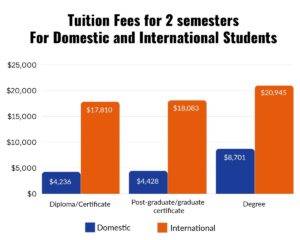Domestic and international students at GBC share their worries about paying for college and the lack of support.
Students at Canadian post-secondary institutions pay thousands of dollars for education every year.
Many of them have debts to pay by the end of their study periods.
Statistics from the Government of Canada show that in 2015, 48 per cent of students in Canada owed debt at graduation. The Canadian Federation of Students Ontario found that in 2019, the average debt owed by a student at graduation was $25,900.
“I think a school is looked at as a luxury item, but it shouldn’t be, it should be a chance for everyone to have… You should be able to study something that you’re interested in,” said Sara Eisazadeh, a domestic student at George Brown College (GBC).
Eisazadeh shared that she has around $3,000 in debt so far.
Domestic students are able to take advantage of loans and grants through the Ontario Student Assistance Program (OSAP). However, students feel that while OSAP has its benefits, it also has its drawbacks.
“I do plan on getting my masters in the future if I can… I probably wouldn’t be relying on OSAP I probably go on the field work there for like a good couple of years getting money off,” said Anmar Ali, another domestic student.
Ali shared that his brother has over $50,000 in student debt after being in school for seven years on OSAP.
International students, on the other hand, do not receive the benefits of OSAP loans and grants. They also pay a much larger amount in fees, up to almost four times the amount paid by their domestic counterparts.
Additionally, International students require health care plans which cost between $500 to $800 at GBC.
“I know for a fact that I pay a lot less than an international student, and to study in a college… That is just crazy to me because you don’t get the same opportunities when you leave college as you would when you leave university. Right and then you’re also so in debt, which just takes away a lot,” Eisazadeh said.
In 2018, International students made the largest contribution to GDP in Ontario with 55.3 per cent of total GDP. Additionally, international students in Ontario pay more than those in other provinces of the country.
Ontario is also the province with the lowest public funding per student in post-secondary education.

International students pay around 4 times higher fees. Graphic by: Sofiia Shabalova
Ansh Arora, an international student from India, will have paid around $32,000 in tuition fees to the college by the end of his 2-year diploma.
“I feel it’s unfair. The government should increase the funding for education, because what I have read in articles is that the education funding is still the same, even though funding for other things has been increased,” Arora said. “It is not easy to manage, you have to work more and also study, having to pay the tuition fee. It does leave an impact.”
Arora has plans to study for a degree, but he hopes to work first to earn money and gain practical experience.
“I would have definitely opted for a degree program but since it’s expensive…they were around 25k a year in degrees. So that would make around 100k per program,” he added.
The struggles that students face in receiving quality post-secondary education are ever present. While high costs may not be fully offset by it, GBC offers various forms of financial assistance to students to help support them in some way.
The college provides several scholarships, bursaries, and awards to full-time students. The awards are given out based on either merits or financial need.
The amount of funding that students receive can vary widely depending on the specific scholarship or award and the policies of the college.
Hazel Nanton, student awards coordinator of GBC said, “Awards and scholarships are important for several reasons. From the perspective of the student, they can help to offset the cost of education, recognize outstanding achievements, and provide opportunities for personal and professional growth. For educational institutions, offering awards and scholarships can help to attract and retain high-performing students, promote academic excellence, and enhance the reputation of the institution.”
The Student Association also provides various bursaries and scholarships for students on the basis of needs and merits.
The Equity and Care Relief fund is also open now for students who belong to six equity groups identified by the Community Care Centre. The fund applications will be open until March. 21.
Awards, Scholarships and bursaries are considered part of a student’s taxable income for the year.
Nanton suggests that students research and understand the eligibility criteria and requirement for each type of aid to familiarize themselves with it.


